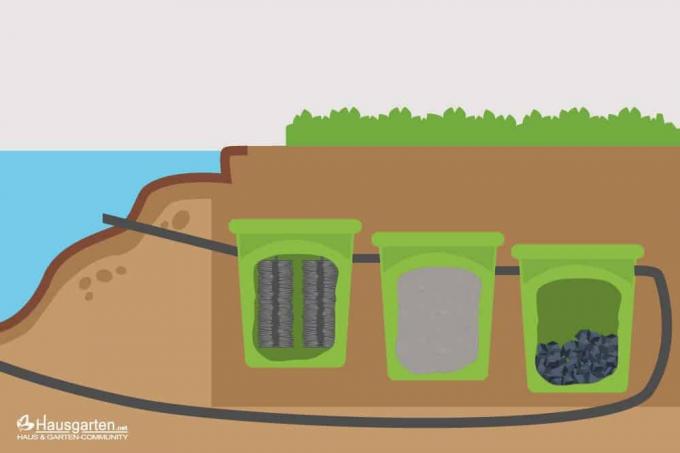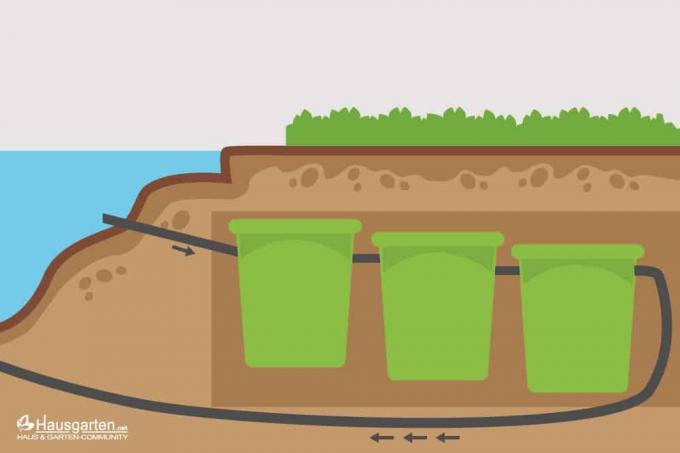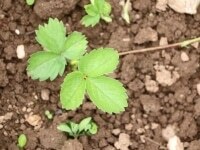

Table of contents
- principle
- Construction
- placement
- material
- Instructions
- Operation
It doesn't matter whether it's a lake, fish pond or stream - in the great outdoors, bodies of water are able to clean themselves. With a garden pond, on the other hand, people have to help. It is far too small to be able to regenerate itself. In addition, dirt usually cannot drain off. Consequently, a filter system is needed that takes on these tasks reliably and effectively.
principle
In every garden pond things are inevitably entered that actually have no place there. Remnants of the lawn mowing, sand, stones and leaves from neighboring trees are definitely part of it. Dead aquatic plants and the remains of fish also pollute the water. If nothing is done about this pollution, the body of water will sooner or later die off. A stock of fish is then no longer to be thought of. Filters take on exactly this cleaning task. They can either be installed directly in the pond or located outside of the water. The latter then usually function according to the principle of gravity - quite simply because the water is not pumped through the individual filter chambers, but following gravity from top to bottom flows through.
Construction

Such a gravity filter consists of several individual chambers that are connected to each other by pipes. Each of these chambers is designed for a very specific filter or cleaning service responsible. It goes from a preliminary or rough cleaning in the first chamber to a fine cleaning in the last chamber. As a rule, a gravity filter today works with three or four filter chambers. The size or the capacity of the chambers depends on the size of the pond. The following applies: the larger the pond, the larger the chambers should be. From the last chamber, the cleaned water then flows back into the pond.
A notice:
Unfortunately, exact size information for the chambers is not possible. In general, it can be said that they can't actually be too big and can be generously designed.
placement
Because the filter chambers of a gravity filter are outside of the pond, they should be integrated into the topography of the garden. They are usually buried, but they can also be placed above ground, which often spoils the look of the garden. If they are not embedded in the ground, a pump is usually required in order to be able to transport the water from the lower pond to the higher filters. When burying, it is essential to ensure that the upper edges of the chambers are at or slightly below the water level. Only then will there be a natural flow of water.
material
By now it should have become clear that the filter chambers are the central elements in a gravity filter. The actual purification of the water takes place in them. The chambers can either be bricked or consist of plastic tubs. Of course, the latter require significantly less effort. Appropriate tubs are available in specialist shops. However, cut open canisters, rain barrels or the so-called Intermediate Bulk Container (IBC) are also suitable.
Tip:
Since the tubs are buried, they should definitely be made of a very robust plastic. High density polyethylene (HDPE) is best suited for this.
In addition, you will need the following materials:
- filter materials
- pipe or hose connections
- sealing material or seals
- fittings
- assembly parts
The filter materials take over the actual cleaning performance. Typically, special brushes are used for rough cleaning, which are hung in the filter chambers. Activated carbon is then used for fine cleaning. It is best to get the filter materials as complete sets from specialist retailers. Care must be taken to ensure that they also fit into the respective chambers. The chambers and their filter content should therefore always be purchased together.
Instructions
Once you have obtained the necessary materials, you can start building the gravity filter. Here's how to do it:
- Dig holes or a continuous trench for the filter pans right next to the pond
- place the tubs in it sloping downwards and connect them with pipes or hoses
- use a pipe to create a supply line from the pond to the first tub
- the pipe should end in the first tub about 20 centimeters below the water level in the pond
- then install a feed line from the last tub back into the pond
- Insert filter materials into the individual chambers and cover the chambers
- Close the trench again, but make sure that the filter chambers remain accessible

By following these basic steps, the gravity filter will sort of work automatically. The natural water pressure from the pond ensures that the water can usually flow through the individual chambers without a pump. The return to the pond also happens almost automatically. Depending on the topographical conditions in the garden, it may still be necessary to interpose a pump. When introducing the filter materials, it is essential to comply with the respective usage or installation instructions are followed. Depending on the manufacturer, there can be significant differences. It is also important to ensure that the filter chambers remain accessible from above. However, they should not always be open, but closed.
Operation
The system is now complete. It can be put into operation immediately. Usually it will work consistently. However, it is recommended to install a tap at the inlet from the pond to the first chamber. In this way, a certain control can take place. In addition, it is often necessary to shut off the water flow when replacing the filter media and cleaning the chambers. Both depend on the degree of pollution, but should be done at least once a year.
 garden editorial
garden editorial I write about everything that interests me in my garden.
Find out more about pond accessories & pond supplies

Brahmi plant, Bacopa monnieri, bacopa - care from A-Z
Known from Indian medicine (Ayurveda), the bacopa is still an insider tip among indoor plants. Known as an aquarium plant for a long time, Brahmi can be found more and more often on the windowsill of Germans and is considered a particularly easy-care plant due to its undemanding nature.

Build your own lettuce tree Tips for the salad tube
If you only have little space, you will quickly reach your limits when it comes to self-sufficiency. Creative solutions, such as the lettuce tree, promise a remedy. We explain how vertical lettuce cultivation succeeds and reveal helpful and useful information about self-cultivation.
Make a pavement yourself – DIY instructions
Since craftsmen cost a lot of money, something that builders usually don't have any money after the house is built, the new owners do a lot of things themselves. Paving the sidewalk(s) is part of it, just like the driveway, the carport base and the like. Properly prepared subsoil is important when paving. Since sidewalks, as the name suggests, are walked on and not driven on, the subsoil does not have to be built up so high and strong. Even the edging is not as important as, for example, the driveway or the carport.

Rose trunk, rose trunk - care
Basically, a rose stem is not a special group of roses, because every rose variety can also be grown as a stem. The finishing points are located at the end of the trunk and thus form a kind of crown.

Build worm compost yourself – make worm castings
Anyone can build their own vermicompost and in this way compost plant and kitchen waste even without their own garden. Avoiding any odor development, an excellent natural fertilizer is created at the same time, while private waste is drastically reduced. A practical guide to building a worm box including making worm castings can be found here.

Multiply strawberries - share seeds / offshoots - that's how it works!
Propagating strawberries is child's play, but it's not only fun for children, it also brings real strawberry flavor into your household forever. You just have to propagate the right varieties, in the article you will learn how it works.



